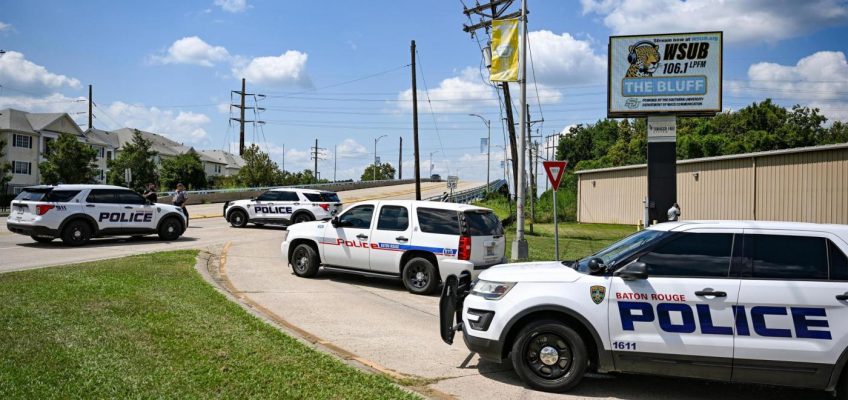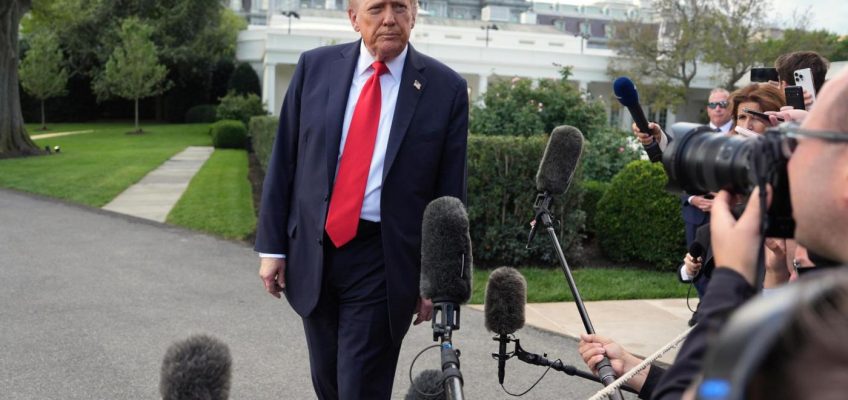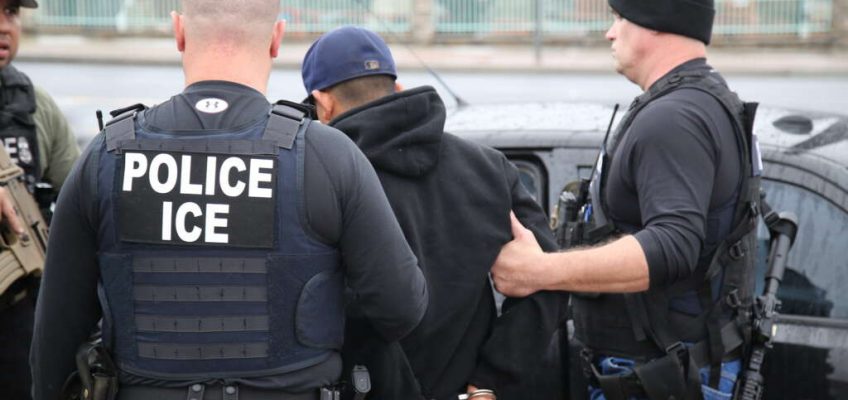En los últimos ocho meses, solo en el estado de Nueva York, en seis condados agencias de policía locales han firmado nueve acuerdos de colaboración con el Servicio de Inmigración y Control de Aduanas (ICE por sus siglas en inglés) en el marco del programa federal 287(g). El número de acuerdos de este tipo se ha disparado en todo el país este año, con un total de 958 que abarcan 40 estados.
Agentes del Servicio de Inmigración y Control de Aduanas de Estados Unidos (ICE) durante una serie de “operaciones selectivas” en 2017. (Flickr/ICE)
Este artículo se publicó originalmente en inglés el 8 de septiembre. Traducido por Daniel Parra. Read the English version here.
Una de las principales estrategias que ha seguido el presidente Donald Trump para llevar a cabo su plan de deportación masiva durante su segundo mandato es mediante la estrategia “inundar la zona” que consiste en abrumar el sistema con una serie de cambios políticos, medidas ejecutivas y un número cada vez mayor de agentes de inmigración.
Los neoyorquinos han sido testigos de todo ello, desde detenciones en los juzgados hasta políticas que restringen el acceso de los hogares inmigrantes a beneficios y programas.
Ahora, a esta estrategia hay que añadir los nuevos acuerdos 287(g), en los que agencias de policía locales se ofrecen voluntariamente para colaborar con el Servicio de Inmigración y Control de Aduanas (ICE por sus siglas en inglés).
En los últimos ocho meses, hasta el 5 de septiembre, se han firmado nueve memorandos de acuerdo de este tipo en el estado de Nueva York, que abarcan seis condados. Como resultado, miles de inmigrantes de Nueva York han sido detenidos por ICE.
Este acuerdo, que recibe su nombre de una sección de la Ley de Inmigración y Nacionalidad, permite a las agencias de policía estatal y local desempeñar las funciones de los agentes de inmigración en virtud de tres modelos específicos de acuerdo 287(g), cada uno con funciones y poderes únicos:
El modelo de agente de ejecución de órdenes judiciales, denominado “287(g)-lite”, permite a los agentes ejecutar órdenes administrativas de ICE contra personas que se encuentran en las cárceles de la policía.
El modelo de aplicación de la ley en las cárceles permite a los agentes examinar a las personas bajo custodia estatal y local por infracciones de inmigración y someterlas a procedimientos de inmigración.
El modelo de grupo de trabajo permite a los agentes realizar detenciones por motivos de inmigración mientras desempeñan sus funciones policiales habituales.
Este nivel de cooperación, según ICE, “mejora la seguridad de las comunidades de nuestro país”, aunque los defensores de inmigración afirman que estos acuerdos erosionan la confianza entre las comunidades y los gobiernos locales.
City Limits se puso en contacto con todas las agencias de policía locales involucradas en estos acuerdos, solicitando cifras sobre arrestos y detenciones en virtud del acuerdo 287(g), pero la mayoría no proporcionó datos específicos.
El número de acuerdos de este tipo se ha disparado en todo el país durante este año, con un total de 958 que abarcan 40 estados, de acuerdo con ICE. Nueva York tiene el mismo número de acuerdos que estados como Indiana y Wyoming.
ICE podría alcanzar 1.000 acuerdos en los próximos meses si la tendencia continúa, ya que hay 31 solicitudes pendientes del programa 287(g) al 5 de septiembre, según la agencia.
Todos los acuerdos actuales de Nueva York se encuentran en condados fuera de la ciudad, pues la ciudad de Nueva York tiene una serie de políticas de “ciudad santuario” que limitan la forma en que las agencias gubernamentales pueden interactuar con las autoridades de inmigración.
A principios de este año, tras reunirse con el zar de la frontera del presidente Trump, Tom Homan, el alcalde Eric Adams intentó autorizar una vez más la presencia de agentes federales de ICE en Rikers Island “para investigar actividades delictivas”, emitiendo en abril una orden ejecutiva firmada por el primer vicealcalde, Randy Mastro. Los agentes de ICE habían sido expulsados anteriormente de Rikers a través de una orden ejecutiva de una década atrás.
Días más tarde, el Concejo de la Ciudad demandó la orden ejecutiva de Adams ante los tribunales, alegando ilegalidad, violaciones de las leyes locales de la ciudad santuario y afirmando que permitir la presencia de ICE en Rikers erosionaría la confianza entre las comunidades y el gobierno de la ciudad. El Concejo consideró que la acción del alcalde era un intento para satisfacer a la administración Trump después de que el presidente retirara una investigación federal por corrupción contra el alcalde.
El lunes, la jueza del Tribunal Supremo del estado, Mary Rosado, se puso del lado del Concejo, declarando ilegal la orden ejecutiva del alcalde y afirmando que tenía “una apariencia inadmisible de conflicto de intereses”, según informó Politico. Mastro dijo que planea apelar.
La presidenta del Concejo, Adrienne Adams, calificó la sentencia del tribunal como “una gran victoria”.
“La agenda política de Trump de utilizar ICE para hacer desaparecer a residentes sin el debido proceso judicial y separar a familias perjudica a nuestras comunidades y socava nuestra seguridad colectiva”, afirmó en un comunicado el lunes por la noche. “Esta decisión protege los derechos civiles de todos los neoyorquinos frente a posibles violaciones y hace que nuestra ciudad sea más segura”.
La presidenta del Concejo de la ciudad, Adrienne Adams, en una manifestación en abril para oponerse al regreso de los agentes de ICE a Rikers Island. (John McCarten/NYC Council Media Unit)
Expansión de ICE en el estado de Nueva York
Sin embargo, la situación fuera de la ciudad es diferente.
Durante años, la oficina del sheriff del condado de Rensselaer fue la única oficina de Nueva York que tenía un acuerdo firmado con ICE.
Pero eso ha cambiado durante este año. En febrero, la oficina del sheriff del condado de Nassau se convirtió en la primera agencia de policía en firmar un nuevo acuerdo con ICE, con programa de servicio de órdenes judiciales. Según los defensores locales, el programa ha provocado protestas y ha suscitado preocupación por la seguridad de los miembros de la comunidad.
“Estamos viendo muchas redadas de ICE en Westbury”, dijo Luba Cortés, coordinadora de defensa de los inmigrantes de Make the Road New York, refiriéndose a un incidente ocurrido en junio en el que se vio a un grupo de agentes de ICE fuera de una escuela local.
“Eso transmite un mensaje equivocado a los miembros de la comunidad, ¿no? ¿Por qué hay una operación policial a gran escala justo enfrente de una escuela primaria?”, añadió Cortés. “Así que la imagen que esto da es realmente preocupante”.
Ha habido protestas frente a la oficina del director ejecutivo del condado, Bruce Blakeman, un candidato con pocas posibilidades de ser gobernador, y quien es aliado de Trump.
En julio, una investigación de Newsday reveló que se había detenido a más de 1.400 inmigrantes y que se habían reservado 50 celdas de la cárcel local para ICE, como parte del acuerdo de servicio de órdenes judiciales firmado por el sheriff del condado, uno de los acuerdos disponibles en virtud del artículo 287(g) que permite a la policía local transferir a la custodia de ICE a los detenidos.
En marzo, el departamento de policía del condado de Nassau (NCPD por sus siglas en inglés) firmó el tipo de acuerdo 287(g) más agresivo: grupo de trabajo, que amplía los poderes de la policía local para participar en actividades federales de control de la inmigración mientras la policía realiza sus funciones habituales. Según ICE, esto implica formar a los agentes de policía locales en materia de legislación migratoria, comunicación multicultural y cómo evitar la discriminación racial.
Un portavoz del NCPD dijo que 10 detectives del condado de Nassau entrenados bajo los parámetros del acuerdo están disponibles para trabajar con ICE, aunque hasta ahora no se ha realizado ningún arresto en virtud de dicho acuerdo. El portavoz dijo que esos detectives recibieron formación en línea a través de ICE, pero no especificó en qué consistía el entrenamiento.
En junio, la Unión de Libertades Civiles de Nueva York (NYCLU por sus siglas en inglés), Latino Justice PRLDEF y Hofstra Law Clinic demandaron al condado de Nassau, lo que supuso la primera demanda contra un acuerdo 287(g) en el estado de Nueva York.
La demanda es en representación de dos residentes de Long Island, así como de tres organizaciones sin ánimo de lucro locales que trabajan con comunidades de inmigrantes: la Diócesis de Long Island, Central American Refugee Center (CARECEN) y HAFALI.
Jessica Greenberg, directora jurídica de CARECEN, afirmó que la comunidad está especialmente asustada, lo que ha provocado una pérdida de confianza en la policía y una reticencia a pedir ayuda cuando surge algún problema.
“Ha habido un aumento de personas que tienen demasiado miedo para llamar a la policía, que se encuentran en situaciones de violencia doméstica. La gente incluso tiene mucho miedo de llamar a una ambulancia”, dijo Greenberg.
Sin embargo, un portavoz del NCPD dijo que el departamento “no ha observado ningún cambio en las llamadas al 911” y que la policía local “sigue teniendo interacciones positivas con nuestros residentes de todas nuestras comunidades”.
Pero la Oficina de Asuntos Hispanos del condado de Nassau, un departamento del gobierno del condado que conecta a la comunidad hispana con los recursos del condado, admite que ha habido reacciones de rechazo.
“Algunos residentes expresan su preocupación y temor, especialmente entre las familias inmigrantes, citando experiencias pasadas o percepciones de discriminación. Otros lo ven como un paso necesario para mejorar la seguridad pública”, dijo Herb Flores, director ejecutivo de la oficina.
“Nadie debe dudar en pedir ayuda, especialmente si es víctima de un delito. La seguridad y el bienestar de todos los residentes son nuestra prioridad, independientemente de su situación migratoria”, añadió Flores, asegurando que los agentes no preguntarán sobre la situación migratoria de nadie, “especialmente si son víctimas de un delito o se encuentran en una situación de emergencia”.
De los diez acuerdos con ICE en el estado, cuatro son programas de grupos de trabajo y cinco son programas de agentes de servicio de órdenes judiciales. Solo uno de ellos, el más antiguo, firmado en 2020 con la oficina del sheriff del condado de Rensselaer, es un modelo de aplicación de la ley en prisiones, que permite a los agentes interrogar a los migrantes en prisión.
En Camden, un pueblo del condado de Oneida, en el centro del estado de Nueva York, el departamento de policía se unió al programa modelo de grupo de trabajo de ICE en julio, solo una semana después de que ICE detuviera al propietario de un antiguo restaurante chino-estadounidense.
El jefe de policía de Camden, Sean Redden, dijo por correo electrónico que “este programa es relativamente nuevo para mí y no lo conozco lo suficiente como para comentar al respecto”.
La oficina del sheriff del condado de Broome, la oficina del sheriff del condado de Madison, la oficina del sheriff del condado de Niágara y la oficina del sheriff del condado de Steuben, que firmó el acuerdo más reciente, no respondieron a las solicitudes de comentarios de City Limits.
En abril, la oficina del sheriff del condado de Broome dijo que 88 migrantes habían permanecido en prisión desde febrero. Los defensores de la zona, situada en la región sur del estado, dijeron que el número había aumentado a unos 140 inmigrantes en julio.
Andrew Pragacz, presidente de Justice and Unity in the Southern Tier (JUST por sus siglas en inglés), dijo que los miembros de su organización llevan casi una década visitando la cárcel. Este año, notó que empezó a llegar más gente.
“Pude visitar a un hombre que ha sido deportado a Guatemala”, dijo Pragacz, y añadió que estaba tratando de ver en qué condiciones se encontraban los inmigrantes, pero muchos fueron trasladados rápidamente a otras instalaciones.
Manifestación en 2019 contra la actividad de ICE en la ciudad de Nueva York. (John McCarten/NYC Council)
Los defensores locales de estos condados están reavivando el llamado para que se prohíba en todo el estado la cooperación del gobierno con ICE. Durante varios años, los legisladores estatales han presentado versiones del New York For All, un proyecto de ley que limitaría la capacidad de los funcionarios estatales y locales para hacer cumplir las leyes federales de inmigración, pero este aún no se ha aprobado.
Estados vecinos, como Nueva Jersey, Connecticut y Delaware, se encuentran entre los pocos que no tienen acuerdos activos con ICE, algunos de ellos después de prohibiciones similares en todo el estado.
A principios de este año, las detenciones, redadas y disturbios de ICE en las comunidades de inmigrantes de todo el estado parecían haber generado el impulso suficiente para que la legislatura aprobara New York for All antes de que finalizara la sesión en junio. El proyecto de ley incluso obtuvo el apoyo de nueve miembros del Congreso de Nueva York, pero no fue aprobado.
“Realmente solo queremos que la gente se centre en New York for All como una campaña que protegería nuestro estado y pondría fin a estos acuerdos 287(g)”, dijo Cortés. “Tom Homan ha dejado muy claro que Nueva York va a ser un objetivo, y depende del estado intervenir y proteger a las personas”.
Para ponerse en contacto con el reportero de esta noticia, escriba a Daniel@citylimits.org. Para ponerse en contacto con la editora, escriba a Jeanmarie@citylimits.org.
The post Acuerdos entre policía local y ICE se han multiplicado en Nueva York y en todo el país appeared first on City Limits.




